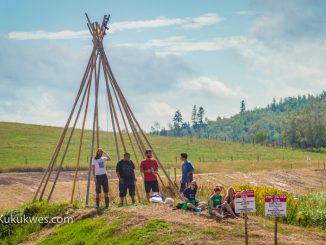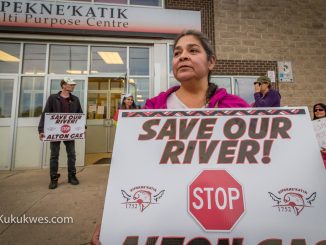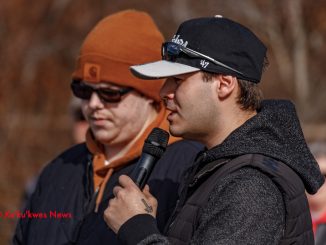
Protesters against a company’s plan to store natural gas in underground salt caverns near Alton, N.S. are turning to an article in the 1752 Peace and Friendship Treaty to step up their opposition to the controversial project.
A group of Mi’kmaw and environmental activists have constructed a treaty “truckhouse” next to the Alton Natural Gas Storage Project LP site along the Shubenacadie River near Stewiake, N.S.
“We’re trying to get people here to feel that they have a right to stand up to protect the water and food sources, food security and water safety,” Cheryl Maloney, president of the Nova Scotia Native Women’s Association, said Monday.
“(The truckhouse has) given us a centre for our activities here for coordination and stuff and most importantly, it’s teaching people about the treaty because there is a truckhouse clause in the Mi’kmaw 1752 Treaty,” she explained.
“It’s very symbolic of our right to be here,” Maloney said.
Truckhouse included in the Peace and Friendship Treaty of 1752

The Peace and Friendship Treaty of 1752 was signed on November 22, 1752 between the Mi’kmaq and the British Crown.
According to article four of the treaty, both parties agree that the Mi’kmaq “shall not be hindered from, but have free liberty of hunting and fishing as usual.”
It also states that the Mi’kmaq can build a truckhouse along the Shubenacadie River “or any other place of their resort” to store merchandise for trading purposes.
The construction of the treaty truckhouse is the latest protest against the Nova Scotia government’s decision in January to allow Alton Natural Gas Storage Project LP to construct salt caverns to store natural gas.
On Friday, protesters occupied the constituency office of federal Fisheries Minister Dominic LeBlanc in Shediac, N.B. The protest was to put pressure on the federal government to designate the Bay of Fundy’s rivers and stream systems, including the Shubenacadie River, a critical habitat for the endangered Inner Bay of Fundy salmon.
Trish MacIntyre, 42, from Halifax was one of the protesters who occupied LeBlanc’s office. She said DFO officials agreed to meet with the group within the next two weeks.
“They actually agreed to come here to the treaty truckhouse that we’ve built,” MacIntyre said on Monday.
Sipekne’katik’s appeal hearing delayed until November
Protests against the Alton Natural Gas Storage project have been ongoing since 2014. Local residents, including Sipekne’katik band members, are concerned with the way in which the company will use water from the Shubenacadie River to create the storage caverns one kilometre underground near Alton, N.S.
The company is using the river water to flush out the salt from the caverns to create a storage place for natural gas coming from the Maritimes and Northeast Pipeline. The salty water mixture, called brine, is then placed in storage ponds before it’s released back into the tidal Shubenacadie River.

Activists like Maloney and MacIntyre are concerned the brine water being released into the river will damage the habitat for species such as salmon and striped bass.
“It’s important to protect the water. It’s important to protect Mother Earth,” MacIntyre said.
In February, several groups, including the Sipekne’katik Band near Shubenacadie, N.S., filed appeals against the provincial government’s decision to give the green light to Alton Gas to construct the salt caverns and a holding pond to store brine water. However, Environment Minister Margaret Miller rejected all six appeals in April.
The Sipekne’katik chief and council responded to Minister Miller’s ruling by filing another appeal with the Nova Scotia Supreme Court as well as stay to prevent the Alton Natural Gas Storage project from dumping brine water into the Shubenacadie River.
Justice Michael Woods dismissed the band’s request for a stay in July and hearing dates for the appeal were rescheduled from August until November.
Meanwhile, a few Mi’kmaw women from various Mi’kmaw communities in the province dropped eel traps in the Shubenacadie River on Sunday near the truckhouse site.
There are also plans to put a fish weir in the river next weekend so the group can begin to monitor the fish and other species, Maloney explained.
“We’re going to establish a baseline and we’re going to establish a conservation area for the Inner Bay of Fundy salmon based on our treaties and our ability to self-govern and manage and be stewards of the environment,” she said.




